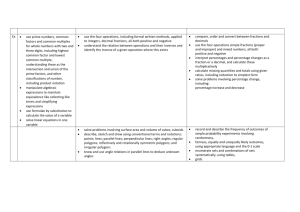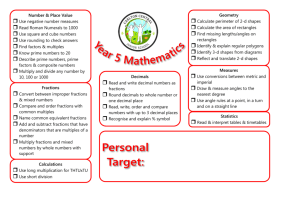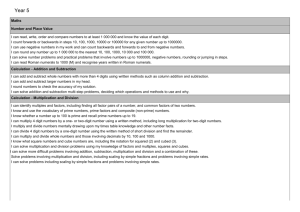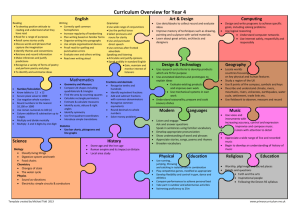Year 5 Maths
advertisement
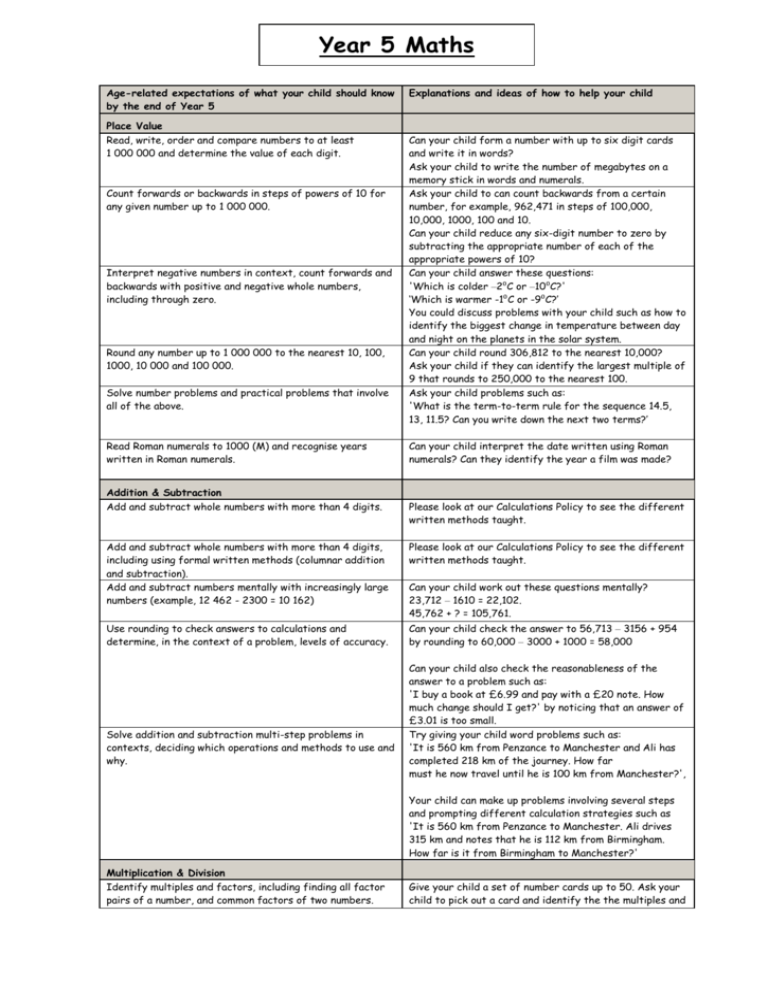
Year 5 Maths Age-related expectations of what your child should know by the end of Year 5 Explanations and ideas of how to help your child Place Value Read, write, order and compare numbers to at least 1 000 000 and determine the value of each digit. Count forwards or backwards in steps of powers of 10 for any given number up to 1 000 000. Interpret negative numbers in context, count forwards and backwards with positive and negative whole numbers, including through zero. Round any number up to 1 000 000 to the nearest 10, 100, 1000, 10 000 and 100 000. Solve number problems and practical problems that involve all of the above. Read Roman numerals to 1000 (M) and recognise years written in Roman numerals. Can your child form a number with up to six digit cards and write it in words? Ask your child to write the number of megabytes on a memory stick in words and numerals. Ask your child to can count backwards from a certain number, for example, 962,471 in steps of 100,000, 10,000, 1000, 100 and 10. Can your child reduce any six-digit number to zero by subtracting the appropriate number of each of the appropriate powers of 10? Can your child answer these questions: 'Which is colder ‒2⁰C or ‒10⁰C?' ‘Which is warmer -1⁰C or -9⁰C?’ You could discuss problems with your child such as how to identify the biggest change in temperature between day and night on the planets in the solar system. Can your child round 306,812 to the nearest 10,000? Ask your child if they can identify the largest multiple of 9 that rounds to 250,000 to the nearest 100. Ask your child problems such as: 'What is the term-to-term rule for the sequence 14.5, 13, 11.5? Can you write down the next two terms?’ Can your child interpret the date written using Roman numerals? Can they identify the year a film was made? Addition & Subtraction Add and subtract whole numbers with more than 4 digits. Please look at our Calculations Policy to see the different written methods taught. Add and subtract whole numbers with more than 4 digits, including using formal written methods (columnar addition and subtraction). Add and subtract numbers mentally with increasingly large numbers (example, 12 462 - 2300 = 10 162) Please look at our Calculations Policy to see the different written methods taught. Use rounding to check answers to calculations and determine, in the context of a problem, levels of accuracy. Can your child check the answer to 56,713 ‒ 3156 + 954 by rounding to 60,000 ‒ 3000 + 1000 = 58,000 Solve addition and subtraction multi-step problems in contexts, deciding which operations and methods to use and why. Can your child work out these questions mentally? 23,712 ‒ 1610 = 22,102. 45,762 + ? = 105,761. Can your child also check the reasonableness of the answer to a problem such as: 'I buy a book at £6.99 and pay with a £20 note. How much change should I get?' by noticing that an answer of £3.01 is too small. Try giving your child word problems such as: 'It is 560 km from Penzance to Manchester and Ali has completed 218 km of the journey. How far must he now travel until he is 100 km from Manchester?', Your child can make up problems involving several steps and prompting different calculation strategies such as 'It is 560 km from Penzance to Manchester. Ali drives 315 km and notes that he is 112 km from Birmingham. How far is it from Birmingham to Manchester?' Multiplication & Division Identify multiples and factors, including finding all factor pairs of a number, and common factors of two numbers. Give your child a set of number cards up to 50. Ask your child to pick out a card and identify the the multiples and factors. For example, the factors of 40 are as 1, 40; 2, 20; 4, 10; 5, 8. Can your child recognise common factors of two numbers, e.g. 5 is a common factor of 40 and 35. Know and use the vocabulary of prime numbers, prime factors and composite (non-prime) numbers. Establish whether a number up to 100 is prime and recall prime numbers up to 19. Multiply numbers up to 4 digits by a one- or two-digit number using a formal written method, including long multiplication for two-digit numbers. Multiply and divide numbers mentally drawing upon known facts. Divide numbers up to 4 digits by a one-digit number using the formal written method of short division and interpret remainders appropriately for the context. Ask your child if they can list the prime numbers up to 19. Can your child apply their knowledge of the prime numbers below 20 to quickly test numbers up to 200 to ascertain whether they are prime? Please look at our Calculations Policy to see the different written methods taught. Try asking your child questions such as: ‘Calculate 25 x 80 x 2.5’ Encourage your child to solve problems such as 'Use the numbers 6, 3, 7, 9, 25 and 50 once each, and use any of the four operations to make the target number of 573' (similar to Countdown). Please look at our Calculations Policy to see the different written methods taught. Multiply and divide whole numbers and those involving decimals by 10, 100 and 1000. Can your child work out: 2.3 x 1000 = 2300 98 ÷ 1000 = 0.098 Discuss with your child how the digits move the left (when multiplying) and to the right (when dividing). Recognise and use square numbers and cube numbers, and the notation for squared (2) and cubed (3). Help your child identify whether a given number is a square number or a cube number up to 100. Can they interpret 6² as 6 x 6 = 36 and 2³ as 2 x 2 x 2 = 8? Help your child to sort the numbers below 200 into a Venn diagram with two sets: square numbers and cube numbers. Can your child also interpret 3⁴ as 3 x 3 x 3 x 3 = 81 and extend the idea to higher powers? Encourage your child to solve problems such as: 'I am thinking of a two-digit number. The difference between its digits is a cube number and the tens digit is a square number. It is a multiple of 13. What is the number?' Solve problems involving multiplication and division including using their knowledge of factors and multiples, squares and cubes. Solve problems involving addition, subtraction, multiplication and division and a combination of these, including understanding the meaning of the equals sign. Discuss problems with your child such as: 'Sam buys seven bottles of water and gets 20p change when he pays with a £10 note. How much was each bottle?' Solve problems involving multiplication and division, including scaling by simple fractions and problems involving simple rates. Can your child solve problems such as: 'Two rulers cost 60p. How much do five rulers cost?' Your child could make up problems such as: 'Helen cycles 40 km in two hours. How far would she cycle in 20 minutes at the same speed?' Fractions (including Decimals & Percentages) Compare and order fractions whose denominators are all multiples of the same number. Identify, name and write equivalent fractions of a given fraction, represented visually, including tenths and hundredths. Give your child two fractions such as 2/3 and 13/18. Can they identify the smaller out of the two? Can they think of a fraction that is between them? Can your child use a fraction wall to show the relationship between halves, thirds, quarters, sixths and Recognise mixed numbers and improper fractions and convert from one form to the other and write mathematical statements > 1 as a mixed number [for example, 2/5 + 4/5 = 6/5 = 11/5]. Add and subtract fractions with the same denominator and denominators that are multiples of the same number. twelfths, and use it to identify groups of equivalent fractions? Are they able to explain why some have several equivalent fractions and others do not have any? Help your child to recognise that improper fractions have a numerator that is larger than the denominator and so can be written as a combination of whole numbers and proper fractions. For example, 8/6 can be written as 1 and 2/6. Can your child calculate 2/6 + 5/6? (same denominator) Can your child calculate 3/4 + 5/12? Multiply proper fractions and mixed numbers by whole numbers, supported by materials and diagrams. Your child could draw diagrams to help them work out 5 x 3/8 = 15/8 or 1 7/8 and hence deduce that 5 x 2 3/8 = 10 + 15/8 = 11 7/8 Read and write decimal numbers as fractions [for example, 0.71 = 71/100]. Ask your child what decimal numbers would be as Recognise and use thousandths and relate them to tenths, hundredths and decimal equivalents. Ask your child to write 1/1000 as a decimal (0.001). Help your child to recognise that ten-thousandths equal one-hundredth and 100- thousandths equal one-tenth. Can your child round 4.76 to the nearest whole number (5) and to one decimal place (4.8). Ask your child if they can identify a number that rounds to 6.6 to one decimal place and is the smallest number for which this is true. Round decimals with two decimal places to the nearest whole number and to one decimal place. fractions e.g. 0.51 as 51/100 and 0.126 as 126/1000 Read, write, order and compare numbers with up to three decimal places. Write down different decimal numbers on pieces of card, for example 2.608 and 2.86. Can your child choose the larger number out of the two? Can they write down a number between them? Solve problems involving number up to three decimal places. Discuss problems such as these with your child: 'I have 2m of ribbon and use lengths of 12.7 cm, 87.5 cm, 23 cm and 47 cm. How much do I have left?' 'I have 12 m of wood split into 1.5 m lengths. I need ten 80 cm lengths, fifteen 15 cm lengths and seven 16 cm lengths. Can I cut this from my wood?' Help your child to recognise that 1%, one-hundredth, 0.01 and 1/100 all represent the same amount. Support your child to write percentages as fractions and decimals e.g. 45% as 45/100 and 0.45. Can they simplify 45/100 to 9/20? Encourage your child to work out the best deal when shopping, for example: ‘Which is more 25% off or 1/3 off the full amount?’ 'Which is more: 20% off or 0.75 off the full amount?' Recognise the per cent symbol (%) and understand that per cent relates to 'number of parts per hundred', and write percentages as a fraction with denominator 100, and as a decimal. Solve problems which require knowing percentage and decimal equivalents of 1/2, 1/4, 1/5, 2/5, 4/5 and those fractions with a denominator of a multiple of 10 or 25. Measurement Convert between different units of metric measure (for example, kilometre and metre; centimetre and metre; centimetre and millimetre; gram and kilogram; litre and millilitre). Understand and use approximate equivalences between metric units and common imperial units such as inches, pounds and pints. Support your child to apply their knowledge of multiplying and dividing by 10, 100 and 1000 and the relationship between metric units to convert 3.1 kg to 3100 g and 250 cm to 2.5 m. Discuss the equivalences of 2.5 cm = 1 inch, 2(.2) pounds = 1 kg to convert between metric and imperial units. You could then discuss equivalences around the house, perhaps a bag of flour or a bottle of milk. Measure and calculate the perimeter of composite rectilinear shapes in centimetres and metres. Draw an ‘L shape’ for your child on a piece of paper. Can they measure the perimeter? Can they estimate the perimeter first? Calculate and compare the area of rectangles (including squares), and including using standard units, square centimetres (cm2) and square metres (m2) . Encourage your child to solve problems such as: 'A rectangle has a perimeter of 20 cm. Its length and width are whole numbers. What possible areas could it have? Which is the largest area?' Draw irregular shapes for your child on squared paper. Can your child estimate the area of the shape by using the squares and parts of squares? Estimate the area of irregular shapes. Estimate volume [for example, using 1 cm3 blocks to build cuboids (including cubes)] and capacity [for example, using water]. Give your child real life scenarios such as: ‘Can you put enough water in the jug to pour drinks for the family?’ ‘Can you fill the kettle so there is enough water to make three cups of tea?’ Solve problems involving converting between units of time. Your child could try solving problems like these: 'What date is it when you reach the one thousandth hour of the year?' 'What date was it when you reached one million minutes old?' Try giving your child problems such as: 'I need 0.6 m of ribbon and my friend needs six times as much. We buy 5 m between us. How much will be left?’ You could then ask your child how much will be left in inches. Use all four operations to solve problems involving measure [for example, length, mass, volume, money] using decimal notation, including scaling. Geometry: Properties of Shape Identify 3-D shapes, including cubes and other cuboids, from 2-D representations. You could give your child drawings of 3d shapes and ask them to identify each one. Know angles are measured in degrees: estimate and compare acute, obtuse and reflex angles. Draw different angles for your child. Can they estimate the size of the angles to within 5⁰? . Draw given angles, and measure them in degrees (0). Using a protractor, ask your child to draw different angles, for example 48⁰ or 195⁰. Could they draw a triangle with angles of 48⁰, 60⁰ and 72⁰? Identify: angles at a point and one whole turn (total 360°); angles at a point on a straight line and 1/2 a turn (total 180°) Support your child to identify in geometric diagrams instances where angles meet at a point and sum to 360⁰ and instances where angles lie on a straight line and so sum to 180⁰. Use the properties of rectangles to deduce related facts and find missing lengths and angles. Can your child solve problems such as: 'The perimeter of a rectangle is 20 cm. One side is 4 cm long. How long are the other sides?' Can your child use the given dimensions of a compound shape to help calculate missing side lengths? You could cut out different polygons for your child to sort. Your child could sort them according to whether they have equal sides and whether they have equal angles. Support your child to understand that polygons with equal sides and equal angles are regular polygons. Distinguish between regular and irregular polygons based on reasoning about equal sides and angles. Geometry: Position & Direction Identify, describe and represent the position of a shape following a reflection or translation, using the appropriate language, and know that the shape has not changed. Discuss with your child the meaning of ‘reflection’ and ‘translation’. Look at different shapes, which have been reflected or translated. Discuss how the shape has not changed in any way. Statistics Solve comparison, sum and difference problems using information presented in a line graph. Complete, read and interpret information in tables, including timetables. Your child could measure the temperature in your house or garden throughout the course of a day and draw a line graph to show the results. You could ask them questions such as: 'When is it warmest? What is the lowest temperature?' You could look at different bus or train timetables with your child. Give your child questions such as: ‘I get to the bus stop at 8:35 a.m. and catch the first bus that arrives. What time do I arrive at the town centre?' by interpreting an appropriate bus timetable. Can your child complete timetables and deduce what is needed from the available information?
